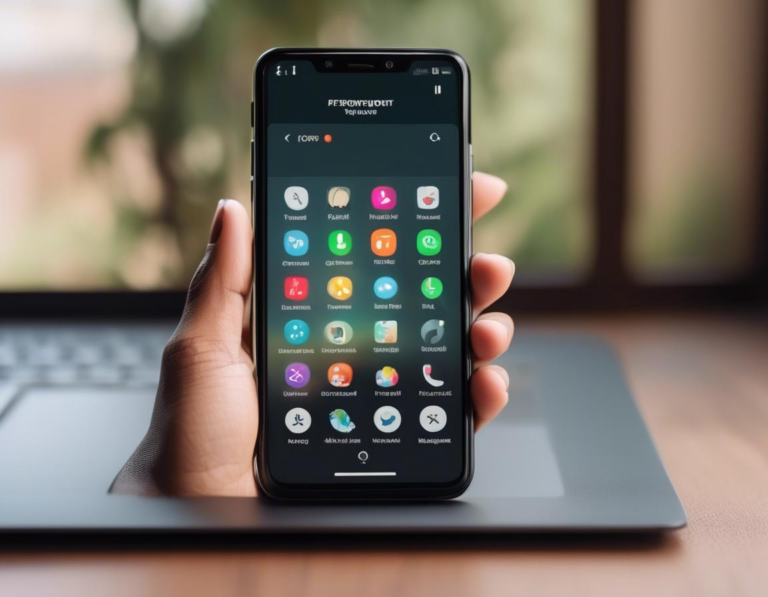How to Optimize Your Cell Phone Setup for Better Performance

Your cell phone is your constant companion, so it’s essential that it runs smoothly and efficiently. Whether you’re a power user or just a casual browser, a well-optimized phone can make a huge difference in your daily experience. In this article, we’ll dive deep into various aspects of phone optimization, from storage management to app optimization, to ensure your device performs at its peak.
1. Storage Management: Free Up Space for Optimal Performance
Your phone’s storage is a precious resource, and it’s crucial to manage it wisely. Over time, your phone can become cluttered with unnecessary files, apps, and data, hindering its overall performance. To ensure smooth operation, follow these storage optimization tips:
- Delete Unused Apps: Regularly review your app list and uninstall apps you haven’t used in months.
- Clear App Cache: Apps store temporary data in their cache, which can build up over time. Clearing app cache can free up significant space. Most phones have built-in tools for this, or you can use third-party apps.
- Offload Unused Apps: This feature allows you to keep apps installed but remove their data from your phone’s storage. When you need them, they’ll download the necessary data.
- Transfer Photos and Videos to Cloud Storage: Utilize cloud storage services like Google Photos or iCloud to store your media files, freeing up valuable space on your phone.
- Check for Large Files: Use your phone’s file management app to identify and delete large files you no longer need. This can be videos, music, or even downloaded documents.
2. App Optimization: Keep Apps Running Smoothly
Apps are a core part of the modern smartphone experience, but they can consume a lot of resources. Optimizing app performance is essential to prevent sluggishness and battery drain.
- Update Apps Regularly: Developers release updates to fix bugs and improve performance. Ensure your apps are up to date to enjoy the latest enhancements.
- Close Unused Apps: While many apps run in the background, only a few are truly essential. Closing unnecessary apps will reduce resource consumption.
- Limit Background Activity: Some apps run in the background even when you’re not using them. You can adjust background data and activity settings for each app individually to control their resource usage.
- Use App Permissions Carefully: Apps request various permissions, such as access to your camera, microphone, or location. Grant permissions only to apps you trust and use sparingly.
3. Battery Optimization: Extend Your Phone’s Lifespan
Battery life is a crucial aspect of smartphone usability. By optimizing your battery usage, you can significantly extend your phone’s operating time between charges.
- Reduce Screen Brightness: A brighter screen consumes more power. Adjust your screen brightness to a comfortable level, particularly in low-light environments.
- Disable Location Services: When not actively using navigation or location-based apps, disable location services to save battery.
- Turn Off Bluetooth and Wi-Fi When Not Needed: These wireless connections consume battery even when not in active use.
- Limit Background App Refresh: Disable background app refresh for apps that don’t require constant updates.
- Use Power Saving Mode: Most smartphones have built-in power-saving modes that limit background activity and reduce screen brightness to extend battery life.
4. Software Updates: Get the Latest Performance Enhancements
Software updates are essential for improving your phone’s performance and security. They include bug fixes, security patches, and new features that can significantly enhance your phone’s overall experience.
- Enable Automatic Updates: Set your phone to automatically download and install software updates. This ensures you have the latest version with all the latest performance improvements.
- Download Updates Over Wi-Fi: Downloading large software updates over mobile data can be slow and expensive. Connect to Wi-Fi to ensure fast and efficient downloads.
- Check for Updates Regularly: If automatic updates are disabled, remember to check for updates manually. You can typically find this in your phone’s settings.
5. Hardware Maintenance: Keep Your Phone in Top Shape
While software optimization is important, maintaining your phone’s hardware is just as crucial. Here are some tips to keep your phone’s hardware in top condition:
- Clean Your Phone Regularly: Dust, dirt, and grime can build up on your phone’s screen, ports, and buttons. Regularly clean your phone with a soft cloth and mild cleaning solution to prevent damage.
- Protect Your Phone with a Case: A sturdy case can protect your phone from scratches, bumps, and falls. This helps maintain its overall appearance and functionality.
- Avoid Extreme Temperatures: Extreme heat or cold can damage your phone’s battery and other components. Keep your phone away from direct sunlight and extreme temperatures.
6. Network Optimization: Boost Your Data Speeds
Your phone’s network connection can significantly impact its performance. Here are some tips to optimize your network connection:
- Use a Strong Wi-Fi Signal: A strong Wi-Fi connection is essential for fast downloads, streaming, and online gaming. Avoid areas with weak Wi-Fi signals.
- Check Your Network Coverage: If you’re experiencing slow data speeds, check your carrier’s coverage map to see if you have adequate signal strength in your area.
- Try Using a VPN: A VPN can encrypt your internet traffic, providing more secure and potentially faster connections.
- Reset Network Settings: If you’re having persistent network issues, resetting your network settings can sometimes resolve the problem.
7. RAM Management: Optimize Memory Usage
RAM (Random Access Memory) is vital for multitasking and overall phone performance. While most phones have enough RAM for typical use, there are ways to optimize memory usage.
- Close Background Apps: Apps running in the background consume RAM. Close unnecessary background apps to free up memory for other tasks.
- Limit Animations and Effects: Fancy animations and visual effects can consume RAM. Reduce these effects to improve overall performance.
- Use a RAM Booster App: While not strictly necessary, RAM booster apps can help manage memory usage and optimize performance.
8. Use a Launcher App: Customize and Optimize
A launcher app lets you customize your home screen and app drawer, potentially improving your overall phone experience.
- Explore Different Launchers: There are numerous launcher apps available on the Google Play Store and Apple App Store. Experiment with different options to find one that suits your preferences.
- Customize Your Home Screen: Arrange your apps and widgets for easy access and create a personalized home screen layout.
- Use Gesture Controls: Some launcher apps offer gesture controls to navigate your phone more efficiently.
9. Use a Performance Monitoring App: Track and Improve
Performance monitoring apps offer insights into your phone’s usage and performance. They can help you identify areas for improvement and optimize your phone for better performance.
- Track Battery Usage: Monitor your battery consumption to identify apps or settings that are draining your battery excessively.
- Monitor CPU Usage: High CPU usage can indicate a performance bottleneck. Use a performance monitoring app to identify apps or tasks that are straining your CPU.
- Analyze RAM Usage: Keep an eye on RAM usage to ensure it’s not consistently maxed out. Close apps or reduce background activity as needed.
10. Conclusion: Enjoy a Smooth and Efficient Phone Experience
By implementing these optimization tips, you can significantly improve your cell phone’s performance and extend its lifespan. Regular maintenance, software updates, and app optimization are crucial for ensuring a smooth and efficient phone experience.
Remember, optimizing your cell phone setup is an ongoing process. Continuously monitor your phone’s performance and make adjustments as needed. With a little effort, you can ensure your phone runs at its best, allowing you to stay connected and productive wherever you go.










